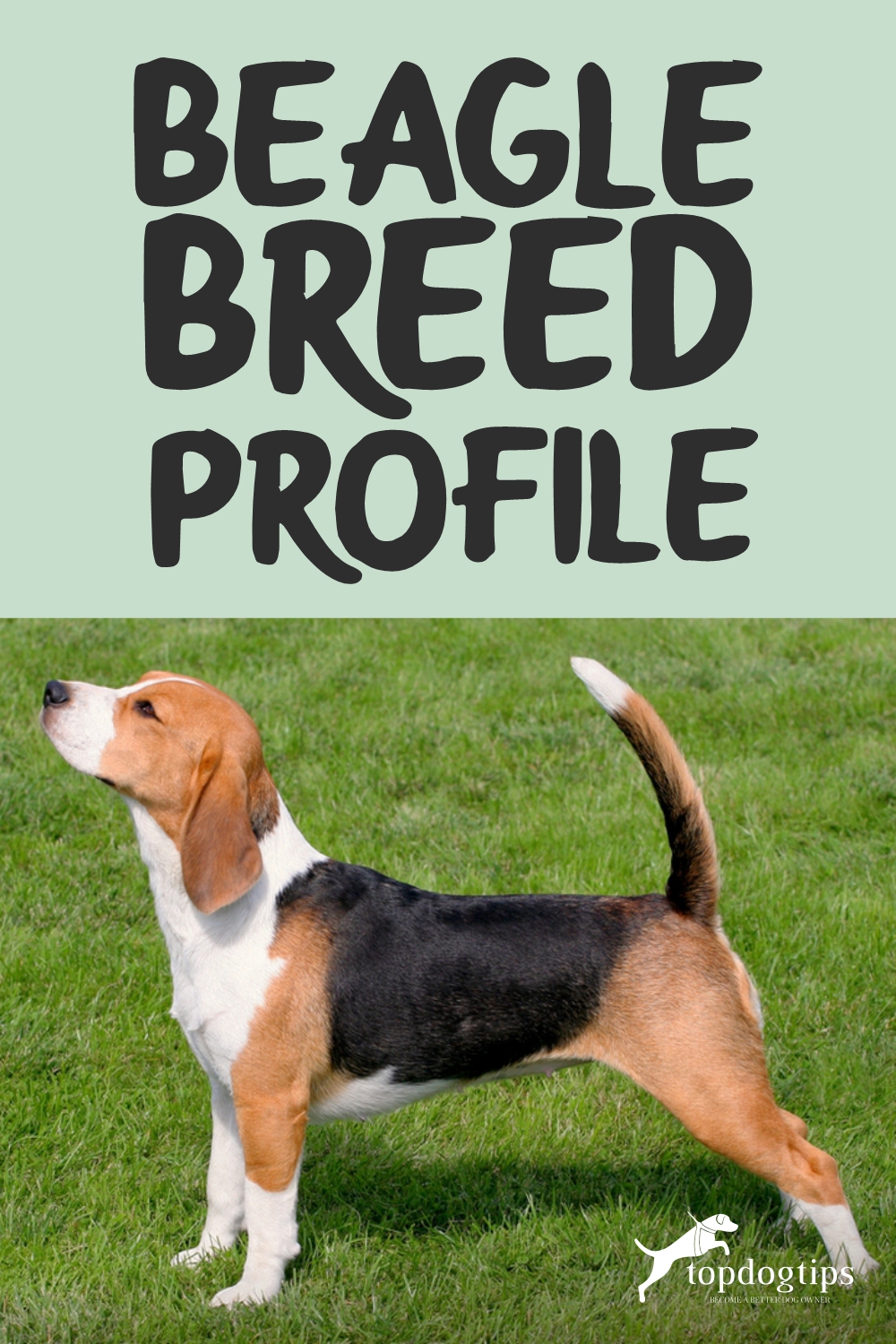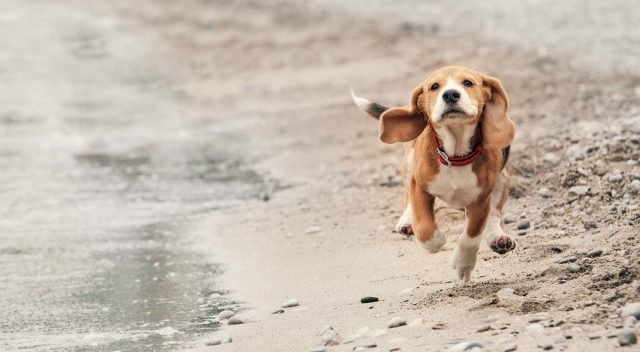
Table of Contents
- All About The Beagle Dog Breed
- Best-Known Beagle Facts
- Beagle Dog Breed History
- Beagle's Personality and Temperament
- Beagle's General Health and Common Ailments
- How to Groom A Beagle
- How To Train and Exercise a Beagle
- What To Feed Beagles
- How are Beagles with Children?
- Where To Adopt a Beagle?
- Beagle Breed: What to look out for?
Beagles are the 5th most popular dog in America, according to the American Kennel Club. This fun-loving dog will amuse you with his antics day in and day out.
But beware that they may take off if they find something that catches their great sniffer.
A Beagle will follow a trail until he catches whatever it is he's looking for.
In this article about the Beagle dog breed, you'll learn what it takes to care for one of these dogs.

As long as you're active in your day-to-day life and able to include your dog, the Beagle will be a great companion for you.
No matter if you're single, with a young family, retired (but able to take your dog for long walks or have an area for him to exercise), or living in the city or in the suburbs, the Beagle will enjoy being by your side.
This breed is small and compact, yet hardy. That makes them a great companion for adults or children.
It's hard to resist their dark brown eyes and adorable features, but you will see that there is a lot more to these dogs than their cute faces.
Although Beagles have a lot of great qualities, they are a member of the hound family.
This means they can also find their fair share of trouble and are bound to test your patience from time to time.
You'll need to be certain that you have plenty of time to train your Beagle, and it may take some creative training to teach him the ropes.
After reading this article, you'll learn that once he's trained, this dog will be a great addition to any home.
All About The Beagle Dog Breed
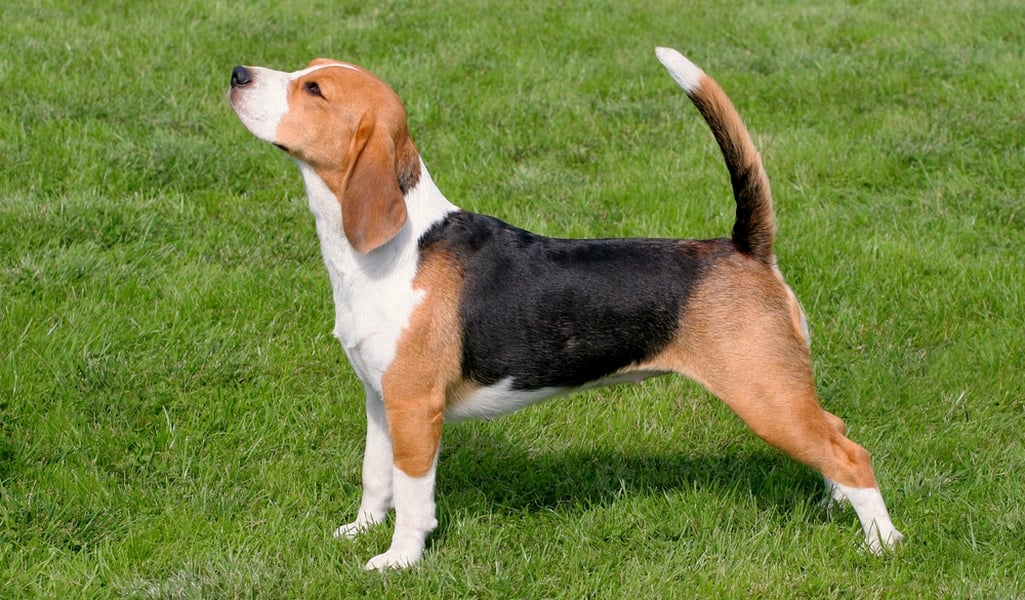
Main Characteristics of the Beagle Hound
Beagles are small in size but medium in energy.
They can go, go, go but will also enjoy curling up with you at night after a fun day of frolicking.
They may be headstrong and stubborn, but this Beagle breed profile will show you that once they know the rules of the house, Beagles can be great pets.
If you're looking for a dog that barely makes a noise, look elsewhere.
If you want a dog that will let you know if anyone is near your house or the other side of the road, the Beagle will definitely alert you. They have a very piercing bark and a howl, which they give off. It is called baying.
Size of Beagles
There are different sizes of this breed. These dogs are known as medium to small dogs since they measure from 13-16 inches high at the shoulder.
Most will weigh between 26-33 pounds. Like all breeds, the female dog is usually smaller than the males.
There are even smaller breeds known as pocket beagles.
Pocket beagles are bred to be a miniature size of the beagle dog.
Could you imagine a forever beagle puppy?!
Lifespan of Beagles
Beagles are going to be long-lasting friends. They will live to be about 12-15 years old. Keep in mind that the way you treat your pet and how well they are fed and exercised will add years or take away years of their lives.
The less strain that they have on their bodies and joints, the happier and healthier they will be.
Proper nutrition and preventative veterinary care will both add years to your pet's life. Before you adopt a new fur-ever friend, you need to be sure you completely understand the cost.
You can't just feed your dog the cheapest stuff you find on the grocery store shelf, and he's going to need regular veterinary care to stay happy and healthy.
Physical Characteristics of Beagles
Beagles are most distinguishable by their trademarked tri-color markings. And if you have any doubt, you can also tell by their small rounded skull, their squared-off muzzle, and wide nostrils.
When you look into their big brown pleading eyes, don't get lost, they can suck you in.
They have wide, long, hanging ears that usually droop down past their muzzle.

Beagles are muscular and have compact bodies that are designed to chase and hunt or to frolic and play. Their tails are usually a blur as they stand straight up and are whip-like. They are constantly wagging and eager to please. There are 11 standard colors that can be found on the Beagle, but they are usually always tri-colored.
The most common combination is White, Black, and Tan. Their coats are short-haired and, if brushed regularly, will be sleek and smooth.
They usually have white feet, and the tips of their tails look like a paintbrush dipped in white paint.
Living Arrangements for Beagles
As you've read in this Beagle breed profile, these dogs are great companions, but they may not be loved by your neighbors if you live in tight quarters.
They require lots of exercise and constant mental stimulation.
If they are bored, they may start amusing themselves with baying and barking.
That's why we don't recommend beagle puppies to dog owners who are away from home a lot.
Beagles thrive in a fenced-in yard where they are able to catch a scent and wander.
If you do live in the city, make sure to keep your Beagle well-exercised and on a leash at all times while outside.
Hunters will find Beagles to be great companions when out rabbit hunting.
They'll help to flush out the prey and chase them down.
Just make sure your dog is well trained to come back before you go out on their first hunting trip or use long leads that allow them to have a head start.
This way, they don't get out of your sight.
RELATED ARTICLE: Labrador Retriever Breed Profile
No matter what your stage of life is, as long as you're home often and able to give lots of time and patience to your Beagle, they'll be a great addition to your family.
And since Beagles are so good with kids, they'll be great for small families as well.
As long as you're able to give them adequate exercise, they'll be great pets for you.
Socialization of Beagles
Beagles, in general, are easygoing, friendly, and curious.
Even though they're barking when someone comes up to the house, it's because they're excited to see them, not out of aggression.
Beagles were bred as pack animals and, as such, do well in a pack. But they're best mixed with other Beagles or humans.
BEAGLES NEED COMPANIONSHIP. THEY NEED TO BE AROUND OTHER DOGS OR HUMANS.
Beagles are barkers, and they will bark at anything that moves close by – kids playing in the park that they can see, someone approaching their house, or sometimes just the leaves blowing in the wind.
They're naturally curious creatures, so they like to draw attention to their findings, and they feel like they're doing a good job protecting and making sure you know that things are moving around in their territory.
If they are left alone too long, they will become destructive, looking for their own means of entertainment.
That's why it's important to enroll your dog in puppy training classes.
If you plan on having them around other dogs, make sure they have been socialized as a puppy and continue to socialize them as they grow.
This will make traveling and interacting with other dogs and humans second nature to your Beagle.

Best-Known Beagle Facts
Beagles are terrific scent hounds, so they were used for hunting.
Because they are scent hounds, their specialty was to pick up a trail and follow it until they found their prey.
Their endurance is such that they won't give up until you make them or they succeed in their pursuit.
They are natural at hunting rabbits and hares of all sizes.
But they wouldn't say no to a good fox hunt either.
After all, there were usually more Beagles on the hunt than there were prey.
After reading this Beagle breed profile, you'll see that these dogs love using their nose to investigate the world around them, and sometimes they can't control the impulse.
Beagles are slaves to their noses.
If left unattended and they catch a whiff of an interesting smell, they will follow it.
Boundaries are not a concern to them – finding the source of the smell is.
If you want to keep your Beagle in your yard, make sure he is either fenced in so he can't get out or keep him on a lead.
Also, when out walking with him, make sure he is always on a leash.
Beagles were bred to be a member of a pack.
They were trained to work together to take down larger prey, or at least to corner it.
Even today, they are comfortable being with other Beagles or creating their own pack, including their humans.
Beagle Dog Breed History
It's unclear who exactly the ancestor of the Beagle is or even which exact breed of the hound it was founded from.
The beagle was bred from hound stock in England, but they were originally uncivil and more like wild dogs than companions.
These Beagles are made for great hunters but are not always the best for companion dogs.
In this Beagle breed profile, we'll explain how Beagles were bred into the lovable family dogs they are today.
It is believed that a strain of these hounds was used in Greece back in the 5th century and also that in the 11th century, a breed known as the Talbot Hound (believed to be an ancient ancestor of the Beagle) was brought to England during the campaigns of William the Conqueror.
The Talbot Hound was bred with different breeds to give it the most desirable qualities of the hunter that are in our Beagles today.
THE BREED HAS SINCE TAKEN OFF TO BE THE 5TH MOST POPULAR BREED IN AMERICA TO DATE.
In 1860, the then-beagle was bred with some even-tempered English breed stock, allowing a new strain of the breed to develop. Thus, it makes a more even-tempered and companionable dog.
In 1887, there were only 18 packs of Beagles to be documented in England, although these Beagle lovers were determined to keep the breed alive.
Two different organizations, The BeagleClub and the Association of Masters of Harriers and Beagles worked hard to bring this number up.
One thing that's important to note in this Beagle breed profile is when these dogs were introduced in the U.S. In the 1870s, General Richard Rowett from Illinois was the first American from England to bring Beagles back with him.
He established his own breeding stock which then became the standard for the American Beagle.
In 1885, Beagles were recognized by the American Kennel Club.
In 1888, the National Beagle Club was founded.
Agility and obedience are highly desirable traits in a Beagle, so the National Beagle Club would hold competitions and shows for this exact reason.
Of course, no beagle breed profile would be complete without discussing the jobs of Beagles in modern times.
They are known to have many desirable jobs as a dog.
Since their sense of smell is so great, many law enforcement officers and search and rescue professionals prefer to use Beagles for search and rescue as well as sniffing out illegal contraband.
Many hunters still use Beagles on their expeditions as well since they are such great tracking dogs.
It takes many, many hours of training in order to get a Beagle to the point of being a working dog.
If you're looking for a pet instead of a worker, you won't need to put in as many hours to keep your Beagle dependable.
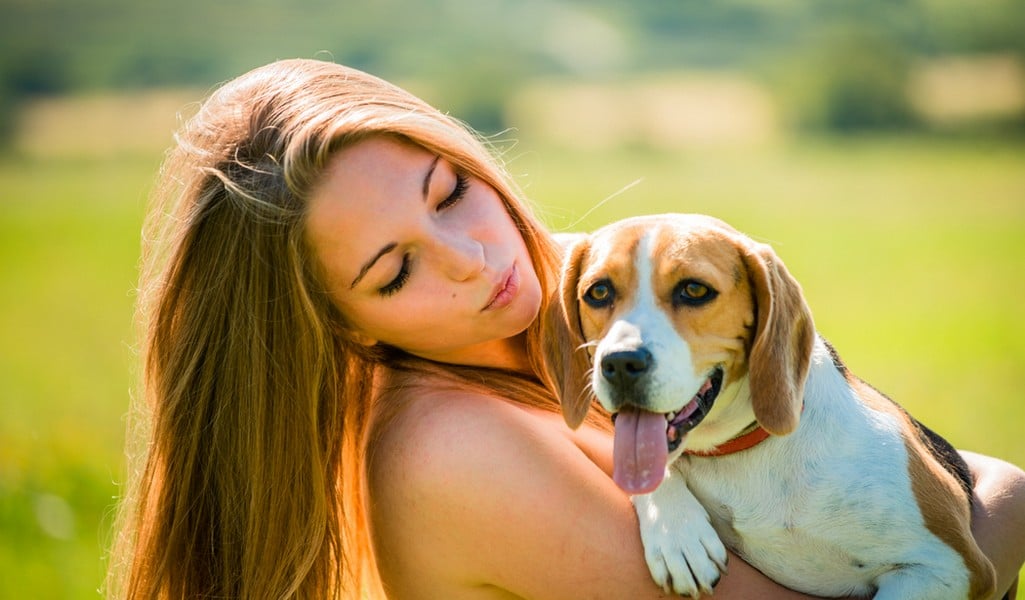 Beagle's Personality and Temperament
Beagle's Personality and Temperament
The modern-day beagle is well known for its eager, gentle, kind, and friendly personality.
They are great family dogs.
They are usually laid back and enjoy relaxing until they catch a scent that catches their attention.
Then, they go on point and are ready for the chase.
They are enthusiastic enough that they will ignore all else to continue on the trail of the smell.
This is the main reason that when you're out with your Beagle, you need to keep him leashed, or you might be chasing after him for a lot longer than you want to be.
It's all about the new adventure for a Beagle.
Beagle's General Health and Common Ailments
Beagles, on the whole, are a very healthy breed. There are not many issues that are common to them, but like all genetics, there are some that will pop up.
Have you ever looked at a hound dog and seen their eyes look like they're constantly bloodshot?
Well, this is known as Cherry Eye, and it's very common in hound dog breeds, including the Beagle.
It is also common when they get older that they will develop cataracts. Have your vet check over your dog often for any early signs and ways to prevent eye disease.
Since Beagles have long-hanging ears, it is also common for them to get ear infections.
These can sometimes (depending on the dog) be easy to avoid. Check the inside of their ears often and wash with a warm cloth to remove wax build-up.
You can use a cotton swab to remove built-up wax in the inner ear, but remember to stay away from the ear canal to prevent causing any damage.
RELATED: Homemade Dog Ear Cleaner: Best Ideas From Around the Internet
Keeping their ears clean will help to keep the ear infections down. If you are having issues with extreme wax build-up, talk to your vet about ear cleaners that you can get for your dog.
If you take anything from this Beagle breed profile, remember the importance of taking proper care of your furry friend.
You can also try natural dog grooming products if you're worried about chemicals and toxins.
Hip Dysplasia is common with many of our four-legged friends.
One important thing to note in this Beagle breed profile is that you need to keep an eye on how often and from how high your dog is jumping.
Other issues that can affect any dog breed include Hypothyroidism, Epilepsy, and Dwarfism.
Have your puppy or new dog checked over by a vet when you bring him home to look for any health conditions.
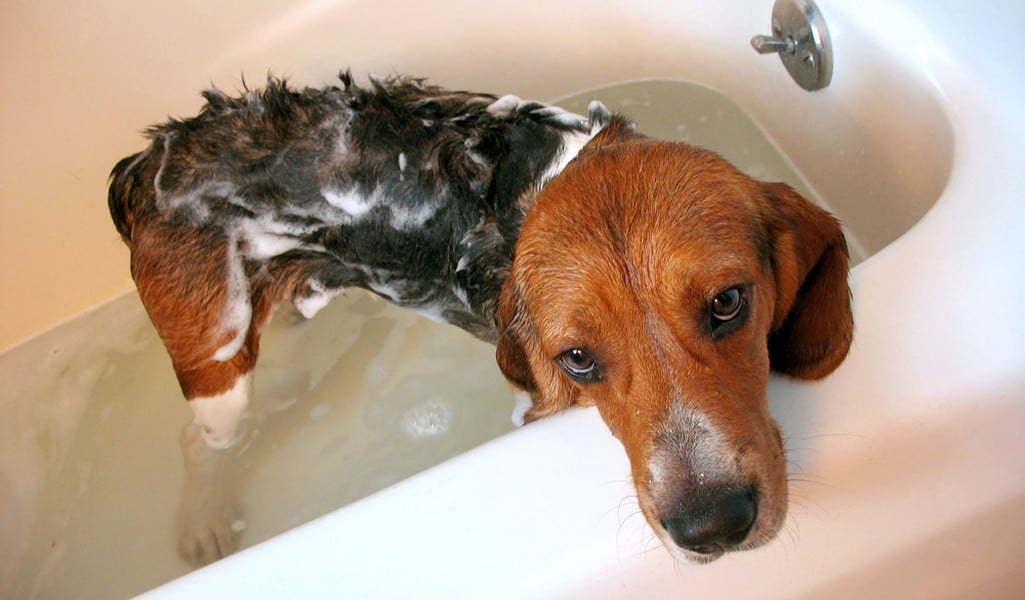 How to Groom A Beagle
How to Groom A Beagle
Beagles have short and sleek coats, and this Beagle breed profile will explain how to properly groom them.
They do shed, and they can actually shed quite a lot. In order to keep the amount of tumbleweeds in your house down, be sure to brush your dog often – about twice a week.
During the change of seasons, you may want to do it a bit more frequently.
Use a hound glove or a shedding tool to work out the loose hair in their undercoat.
Ears
Keeping your beagle's ears clean and dry is key to keeping him out of pain from ear infections.
Use a damp cloth with warm water to wipe the inside of his ears, and you can use a cotton swab to go near the inside of the ear to remove the clumps of wax.
Make sure to stay away from the ear canal to avoid causing problems.
Nails
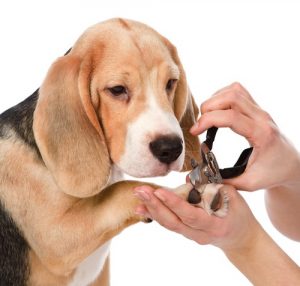
The more your Beagle runs and digs in his nails, the more they will naturally wear down. If his normal exercise is going for a leashed walk or just trotting around the yard, his nails won't wear down enough to keep them short. Make sure to trim or grind the nails down on a regular basis.
Nails that are too long can cause pain to your dog.
They are prone to breaking or cracking and can get caught and ripped off if they are too long, causing you an unexpected trip to the vet.
Doing some preventative care will keep your dog happy and healthy in the long run.
Teeth
Oral care is very important to helping your dog keep all of his teeth.
You can brush his teeth on a regular basis and also use teething products such as greenies, dent-a-bone, or just natural products like antlers and cow bones.
Working away the extra plaque and grime that gets stuck on your dog's teeth will help to keep him healthy.
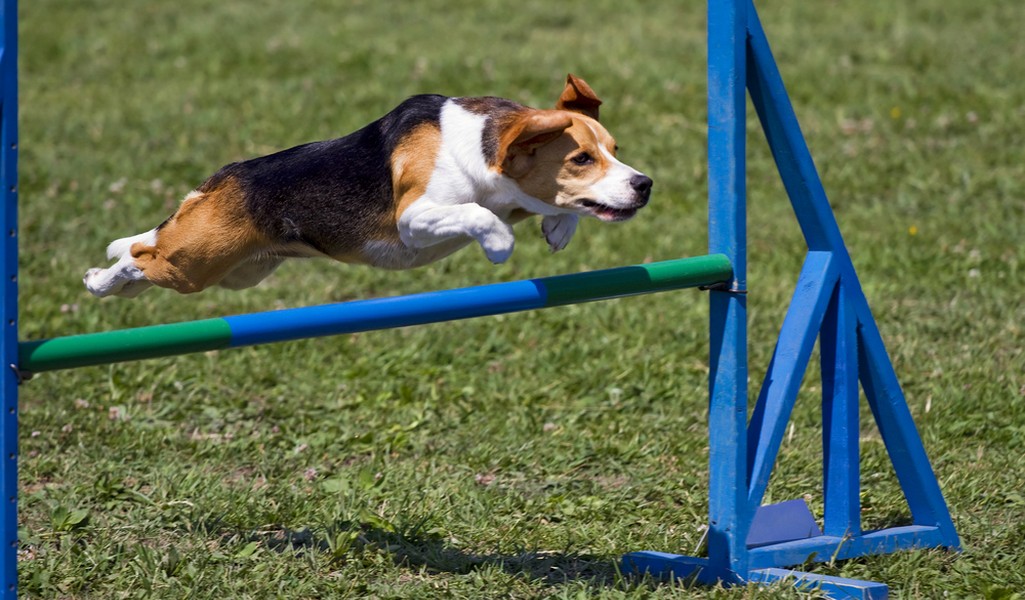 How To Train and Exercise a Beagle
How To Train and Exercise a Beagle
Beagles can be stubborn and hard to train, but with patience, you should be able to get through to them.
Use their strong sense of smell to incorporate tracking exercises into their training.
Using treats and smells is a great way to get your Beagle trained in agility.
One thing you should take away after reading this Beagle breed profile is that these dogs are highly intelligent, making them capable of being trained to do almost anything if you're willing to put in the effort.
Have a toy that you add a smell to, walk it around, and rub it against different items like rocks, bushes, or anything else that you can find.
Then hide the toy and let your Beagle sniff it out. Doing this in a fenced-in yard is preferable so you can let your dog go and let him explore to find the trail on his own.
Give lots of encouragement and a reward when he has found the toy.
Using meat is also a great way to do this, especially if you're looking for a dog to help you in hunting.
RELATED: Agility Training For Dogs: Ultimate Beginners Guide
If you're going to be taking your Beagle out hunting, make sure you teach him how to hunt and chase without eating the prey, or your catch may not be usable to you.
A Beagle breed profile would not be complete without this important piece of advice: be sure to teach yourself who the Alpha/Master is.
This will go a long way to teaching him who he needs to respect and listen to. It will also help him listen while inside the house.
Consistency is key to training your dog.
Make sure that everyone in the household is working towards training your pet, at least in the household rules.
Exercise
Beagles are medium-energy dogs. They aren't the most hyper breed, but they do need to get that pent up energy out. Going for long walks every day will help to keep your dog happy.
Having a fenced-in yard where he can romp around at his own leisure would be great, too.
One important thing to take away from this Beagle breed profile is that this breed needs regular exercise or they will become a handful very quickly.
You'll want to keep your Beagle leashed or in a fenced-in yard at all times, or he may find a scent and follow it.
If that were to happen, he would be gone before you even noticed. Don't let their small size fool you; these dogs are fast!
The more exercised your Beagle is, the happier he will be and the more content he will be to relax inside the house.
If he is understimulated, there is a good chance that he will eventually find his own ways to entertain himself, which can cause you a lot of headaches.
Having your dog well-trained and exercised will go a long way to having a happy household.
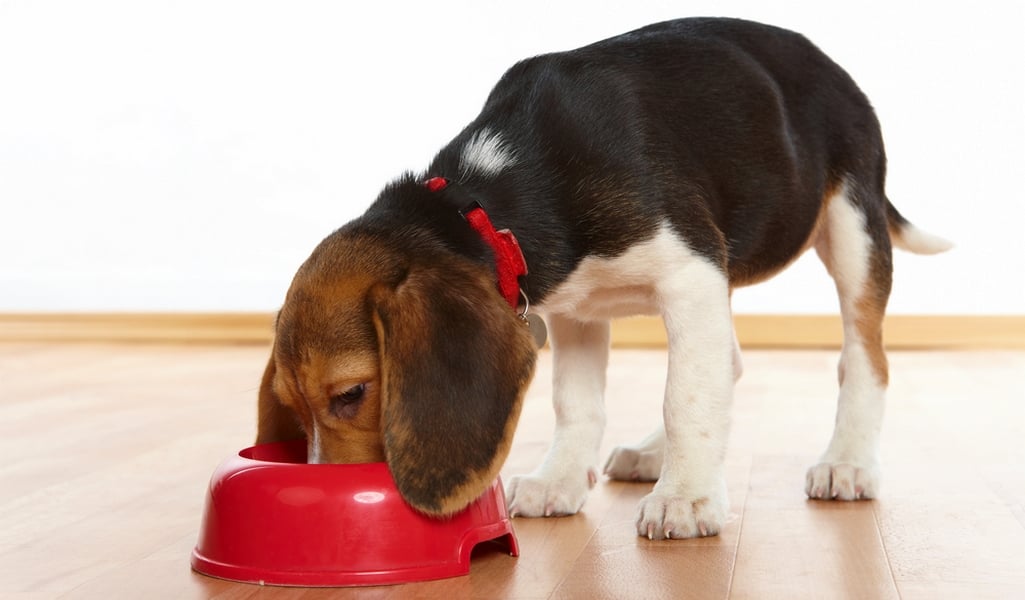
What To Feed Beagles
Healthy nutrition is very important to keeping your Beagle lean, trim, and healthy.
One of the key things to point out in this Beagle breed profile is that these dogs love food!
When Beagles overeat, they can become obese, which causes a lot of strain on their joints and organs.
This will increase their chances of having hip dysplasia and hypothyroidism.
Keep your Beagle to just dog food (the higher the grade, the better), and keep the table scraps away.
Most dog food manufacturers have specific types of products for different breeds or at least for a small dog versus a big dog. You need to buy your Beagle high-quality food for small dogs.
You'll also want to watch out for the amount of fillers that are in the food.
Go for meats over grains when picking your dog food.
Beagles will hunt down anything that smells good no matter where it is, be it in the garbage, dishwasher, counter, table, or on the floor.
If they can smell it and reach it, they will try to eat it.
Make sure you are keeping an eye on what your Beagle is eating and how much.
This goes for treats as well. It's easiest to train Beagles by the scent of treats, but it's best to keep these limited and to use more encouragement as time progresses.
Some dog treats are very high in calories, so you want to be sure to purchase healthy training treats that have less than 5 calories each.
And, of course, keep the number of treats to a minimum.
Best Dog Food for Beagles
Picking the best food for Beagles is important if you want to optimize their health and cater to this specific breed's needs.
Focusing not only on good quality dog food with healthy ingredients but also on what your specific dog requires in terms of energy and protein should be the main focus of every owner with a Beagle.
Here are quick picks for the best dog food for Beagles:
- Taste of the Wild Dry Dog Food, Pacific Stream Canine Formula
- ROYAL CANIN BREED HEALTH NUTRITION
- Acana Wild Prairie Dry Dog Food
- Dr. Harvey's Paradigm Green Superfood Dog Food
- Orijen Adult Dog Food
You can find more information on the general best dog food brands in this review.
How are Beagles with Children?
Since Beagles are so easy-going and laid back, they're great with children.
As previously mentioned in this Beagle breed profile, they will be able to take all the play that kids have to offer and enjoy going on adventures with the kids as they get older.
Beagles are small in stature, so you won't have to worry about them knocking the kids over all the time.
Watch out for meal times and snack times.
Kids are walking vending machines to dogs, and if you're keeping your Beagle on a strict diet it'll be hard to do if he's sneaking the kid's meals and snacks.
Make sure that play between small children and dogs is always supervised to keep everyone safe.
Teaching your children how to play with dogs is very important.
You need to be just as diligent about teaching your children the right way to act around dogs as you are about teaching your dog how to act around children.
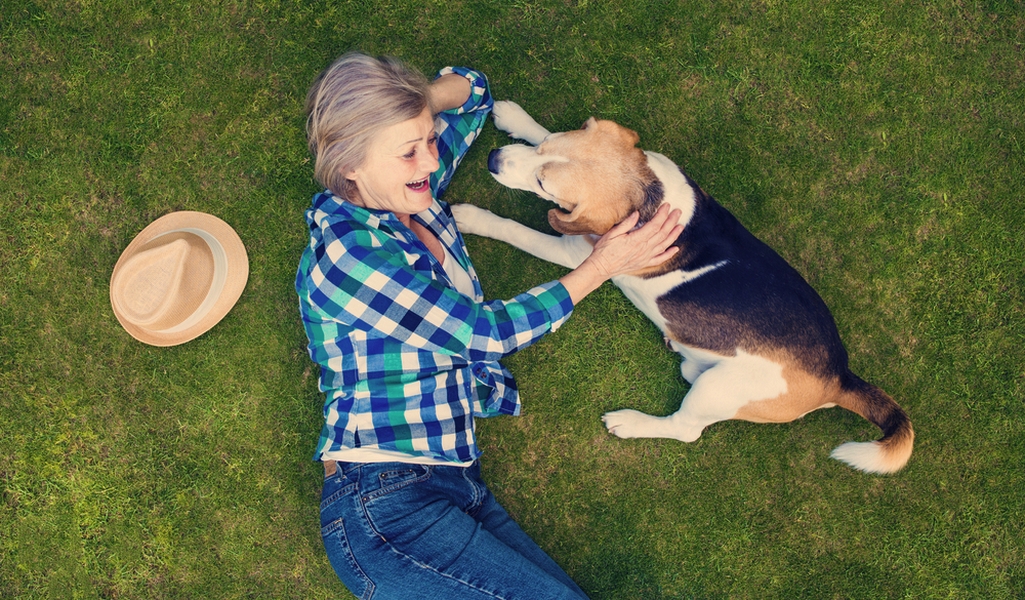
Where To Adopt a Beagle?
There are three different ways to acquire your new Beagle. Of course, that needs to be discussed in a Beagle breed profile.
Odds are, if you're reading this, you're probably doing research on the breed because you're interested in adopting.
You can go through a Breeder, an adoption shelter, or through a Beagle club to find your new furry friend.
Find A Reputable Beagle Breeder
Although at one time, Beagles were rare, this is no longer the case. Being the 5th most common dog in America, they are now pretty easy to find.
Since only so many puppies can be born at once, you may still end up on the waiting list for a new puppy from a reputable breeder.
Later in this Beagle breed profile, you'll also learn about rescuing pre-loved Beagles from shelters.
Looking for a reputable breeder should be of your highest concern when looking to purchase your new puppy. Look for someone who is interested in you and your family and how you live. You'll want a breeder who is interested in the welfare of their pups and where they are going to be placed.
REPUTABLE BREEDERS WILL ALSO MAKE SURE THAT THE ADULTS ARE WELL-TAKEN CARE OF, THAT THE PUPS ARE WELL SOCIALIZED AND THAT THE LITTERS ARE IN A CLEAN SAFE AREA.
Your breeder should be open and honest about the different diseases that are genetic in Beagles, and they should have several different tests done on the puppies before you get them.
The pups should also be registered with the Orthopedic Foundation for Animals (OFA); the tests done for this registration include hip dysplasia, elbow dysplasia, and hypothyroidism.
The puppies should have their eyes tested through the Canine Eye Registry Foundation.
You can check that these tests have been done and what their results are on the OFA website.
Keep in mind that all results are available on the OFA website, not just the passing tests.
You'll need to make sure to check what the score is before adopting your new puppy.
Adoption Shelter
Unfortunately, for many different reasons, Beagles cannot always stay in their home. This does not mean that they are bad dogs or even that it's a problem with the dog.
Some could have come into the shelter due to a breakdown in the home or the passing of a loved one. Many of these dogs are great and just need a new forever home.
Let's face it, you can skip the puppy stage by doing this.
There are many great sites that you can go to in hopes of finding your new companion, and of course, you should try to find out as much information as you can about these dogs.
By adopting an adult Beagle, you'll also be able to quickly see if there are any issues with the older dogs.
Hip dysplasia and other genetic defaults will be more prominent in older Beagles.
Some sites to check out include:
- Beagle Adoption Canada
- Adopt-a-pet.com
- Petfinder.com
- Beagle Rescue League, Inc
- Big on Beagles
- Beagles & Buddies
Clubs
The Beagle Club is a great place to gather information on where to find and acquire your new Beagle. They will also help you with any questions that you may have about your new dog or about any breeders.
The Beagle Club is an excellent resource for finding reputable breeders or dogs who are in need of a loving family.
Beagle Breed: What to look out for?
When acquiring your new puppy, you want to, first and foremost, stay clear of puppy mills. That is one thing that this Beagle breed profile needs to make very clear. Places that are just in it for the money and don't actually care for the well-being of the dogs or where they are going to be placed are not responsible options. Other signs of puppy mills are how the dogs are housed and how much litter is on the go at any given time.
Other sure signs of wrongdoing are when there are no papers available for your new dog (unless you are getting a shelter dog under certain situations).
All new puppies should have their shots and be tested by vets and professionals before they can be given out.
Puppies should never be taken away from their mothers before they reach the age of 8 weeks.
They need this time to learn proper socialization skills and also have time for all of their checkups.
Related Reads
Disclosure: We may earn affiliate commissions at no cost to you from the links on this page. This did not affect our assessment of products. Read more here and find full disclosure here.


